Economics Assignment 1: Microeconomic Factors and Business Decisions
VerifiedAdded on 2021/04/17
|25
|5448
|29
Report
AI Summary
This economics assignment delves into the microeconomic business environment, examining the factors that shape business decisions and profitability. It begins by defining the microeconomic environment and its importance, differentiating it from the macroeconomic environment. The report then explores key microeconomic components, including factors of production (labor, land, capital, and entrepreneurship) and their scarcity, emphasizing the need for optimal resource allocation. The assignment analyzes demand and supply dynamics, illustrating how changes in consumer income, prices, and preferences affect market equilibrium. It also discusses business behavior and objectives, highlighting profit maximization, cost minimization, and the three fundamental economic questions (what, how, and for whom to produce). The concept of elasticity of demand is explained, along with regulatory strategies like price ceilings and floors. Finally, the report examines the impact of different market structures (monopoly, oligopoly, perfect competition, and monopolistic competition) on businesses, emphasizing the importance of understanding market dynamics for long-term sustainability. This assignment provides a comprehensive overview of microeconomic principles and their practical applications in the business world.

Running head: ECONOMICS ASSIGNMENT
Economics Assignment
Name of the Student
Name of the University
Author Note
Economics Assignment
Name of the Student
Name of the University
Author Note
Paraphrase This Document
Need a fresh take? Get an instant paraphrase of this document with our AI Paraphraser
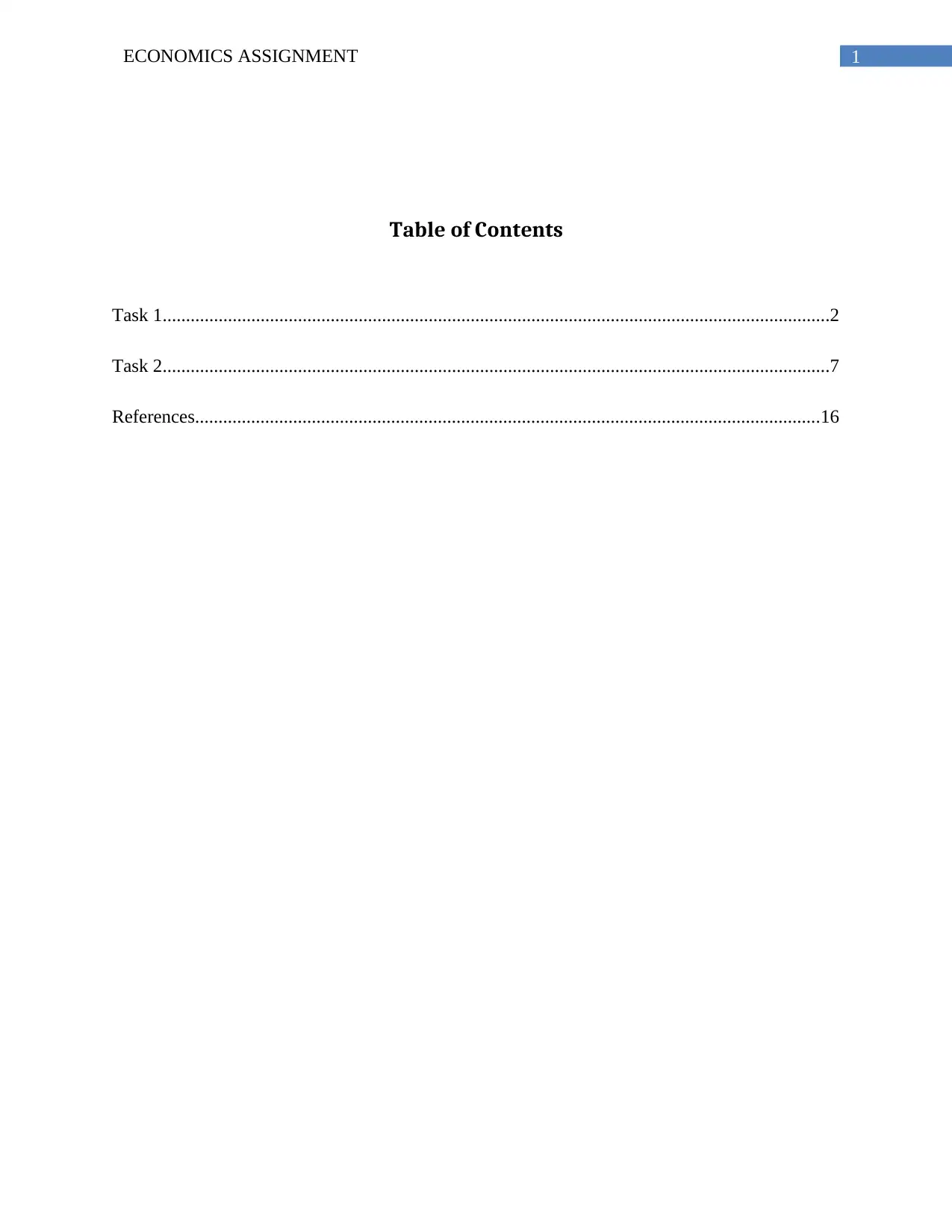
1ECONOMICS ASSIGNMENT
Table of Contents
Task 1...............................................................................................................................................2
Task 2...............................................................................................................................................7
References......................................................................................................................................16
Table of Contents
Task 1...............................................................................................................................................2
Task 2...............................................................................................................................................7
References......................................................................................................................................16

2ECONOMICS ASSIGNMENT
Task 1
Understanding the micro-economic business environment
Economics, as a discipline itself, has immense implications in the multidimensional
aspects of the growth and activities of a country. The commercial and industrial operations,
amongst these aspects, are primarily dependant on the different economic variables, factors and
their dynamics in the domain where they operate. These economic factors are broadly classified
into microeconomic and macroeconomic ones (Baumol and Blinder 2015). The microeconomic
aspects in the operational framework of a concerned business, are those aspects which are
subjective to the concerned organization and its decision making process only. Keeping this into
consideration, the concerned article tries to discuss and analyze the micro-economic components
which are present in the business environment in general and which have implications on the
business decisions as well as profitability and sustainability of the same.
Microeconomic environment of a business: Importance and Implications
The overall environment, under which a business usually operates, can be divided into
micro and macro environments. The former, as can be gauged from the term itself, refers to the
specific and unique subjective task environment of a particular commercial institution, which
have considerable implications on the regular working framework of the businesses. Unlike the
implications of the macro environment of the businesses, the effects of any changes or dynamics
in the micro environment are seen on the businesses in the short run itself (Babatunde and
Adebisi 2012).
Task 1
Understanding the micro-economic business environment
Economics, as a discipline itself, has immense implications in the multidimensional
aspects of the growth and activities of a country. The commercial and industrial operations,
amongst these aspects, are primarily dependant on the different economic variables, factors and
their dynamics in the domain where they operate. These economic factors are broadly classified
into microeconomic and macroeconomic ones (Baumol and Blinder 2015). The microeconomic
aspects in the operational framework of a concerned business, are those aspects which are
subjective to the concerned organization and its decision making process only. Keeping this into
consideration, the concerned article tries to discuss and analyze the micro-economic components
which are present in the business environment in general and which have implications on the
business decisions as well as profitability and sustainability of the same.
Microeconomic environment of a business: Importance and Implications
The overall environment, under which a business usually operates, can be divided into
micro and macro environments. The former, as can be gauged from the term itself, refers to the
specific and unique subjective task environment of a particular commercial institution, which
have considerable implications on the regular working framework of the businesses. Unlike the
implications of the macro environment of the businesses, the effects of any changes or dynamics
in the micro environment are seen on the businesses in the short run itself (Babatunde and
Adebisi 2012).
⊘ This is a preview!⊘
Do you want full access?
Subscribe today to unlock all pages.

Trusted by 1+ million students worldwide
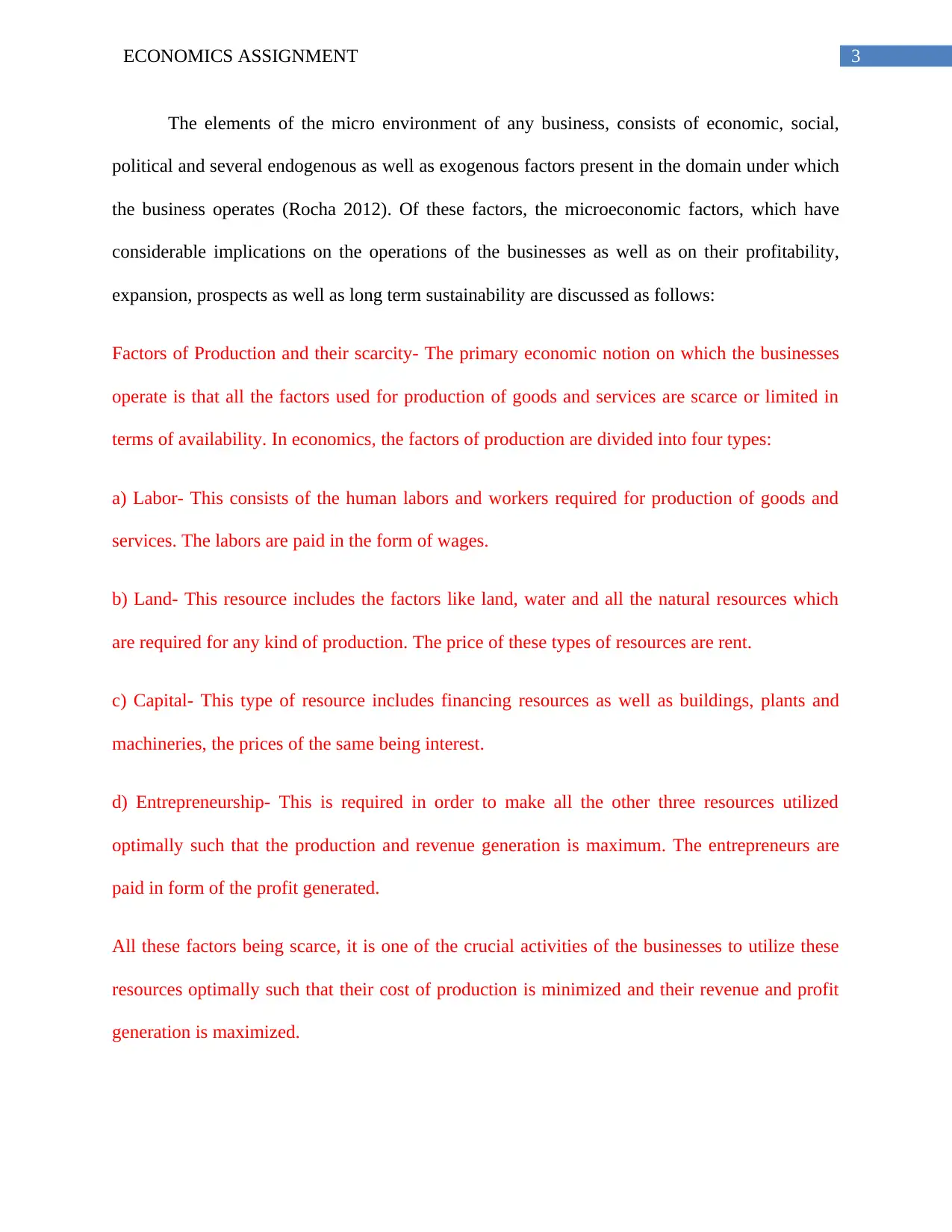
3ECONOMICS ASSIGNMENT
The elements of the micro environment of any business, consists of economic, social,
political and several endogenous as well as exogenous factors present in the domain under which
the business operates (Rocha 2012). Of these factors, the microeconomic factors, which have
considerable implications on the operations of the businesses as well as on their profitability,
expansion, prospects as well as long term sustainability are discussed as follows:
Factors of Production and their scarcity- The primary economic notion on which the businesses
operate is that all the factors used for production of goods and services are scarce or limited in
terms of availability. In economics, the factors of production are divided into four types:
a) Labor- This consists of the human labors and workers required for production of goods and
services. The labors are paid in the form of wages.
b) Land- This resource includes the factors like land, water and all the natural resources which
are required for any kind of production. The price of these types of resources are rent.
c) Capital- This type of resource includes financing resources as well as buildings, plants and
machineries, the prices of the same being interest.
d) Entrepreneurship- This is required in order to make all the other three resources utilized
optimally such that the production and revenue generation is maximum. The entrepreneurs are
paid in form of the profit generated.
All these factors being scarce, it is one of the crucial activities of the businesses to utilize these
resources optimally such that their cost of production is minimized and their revenue and profit
generation is maximized.
The elements of the micro environment of any business, consists of economic, social,
political and several endogenous as well as exogenous factors present in the domain under which
the business operates (Rocha 2012). Of these factors, the microeconomic factors, which have
considerable implications on the operations of the businesses as well as on their profitability,
expansion, prospects as well as long term sustainability are discussed as follows:
Factors of Production and their scarcity- The primary economic notion on which the businesses
operate is that all the factors used for production of goods and services are scarce or limited in
terms of availability. In economics, the factors of production are divided into four types:
a) Labor- This consists of the human labors and workers required for production of goods and
services. The labors are paid in the form of wages.
b) Land- This resource includes the factors like land, water and all the natural resources which
are required for any kind of production. The price of these types of resources are rent.
c) Capital- This type of resource includes financing resources as well as buildings, plants and
machineries, the prices of the same being interest.
d) Entrepreneurship- This is required in order to make all the other three resources utilized
optimally such that the production and revenue generation is maximum. The entrepreneurs are
paid in form of the profit generated.
All these factors being scarce, it is one of the crucial activities of the businesses to utilize these
resources optimally such that their cost of production is minimized and their revenue and profit
generation is maximized.
Paraphrase This Document
Need a fresh take? Get an instant paraphrase of this document with our AI Paraphraser
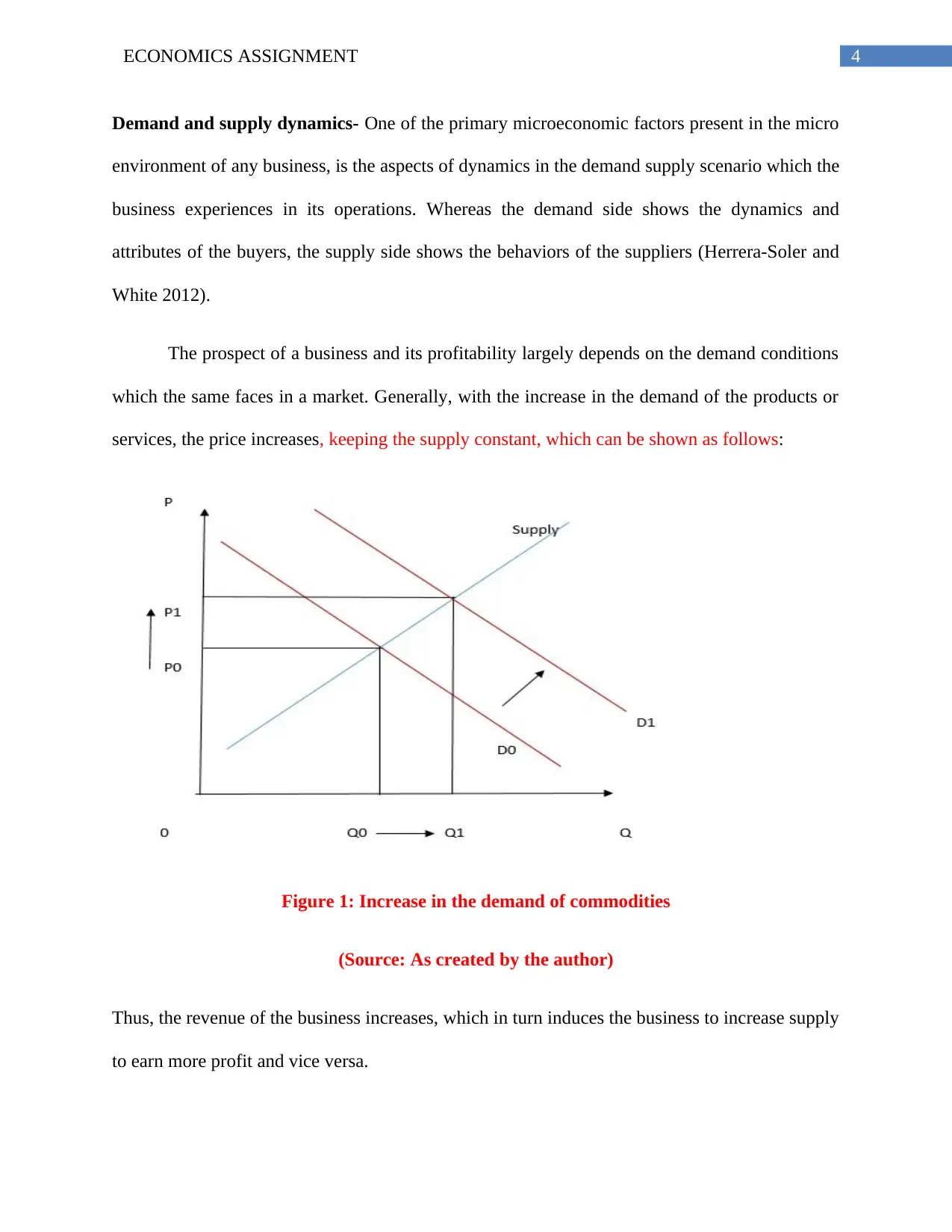
4ECONOMICS ASSIGNMENT
Demand and supply dynamics- One of the primary microeconomic factors present in the micro
environment of any business, is the aspects of dynamics in the demand supply scenario which the
business experiences in its operations. Whereas the demand side shows the dynamics and
attributes of the buyers, the supply side shows the behaviors of the suppliers (Herrera-Soler and
White 2012).
The prospect of a business and its profitability largely depends on the demand conditions
which the same faces in a market. Generally, with the increase in the demand of the products or
services, the price increases, keeping the supply constant, which can be shown as follows:
Figure 1: Increase in the demand of commodities
(Source: As created by the author)
Thus, the revenue of the business increases, which in turn induces the business to increase supply
to earn more profit and vice versa.
Demand and supply dynamics- One of the primary microeconomic factors present in the micro
environment of any business, is the aspects of dynamics in the demand supply scenario which the
business experiences in its operations. Whereas the demand side shows the dynamics and
attributes of the buyers, the supply side shows the behaviors of the suppliers (Herrera-Soler and
White 2012).
The prospect of a business and its profitability largely depends on the demand conditions
which the same faces in a market. Generally, with the increase in the demand of the products or
services, the price increases, keeping the supply constant, which can be shown as follows:
Figure 1: Increase in the demand of commodities
(Source: As created by the author)
Thus, the revenue of the business increases, which in turn induces the business to increase supply
to earn more profit and vice versa.
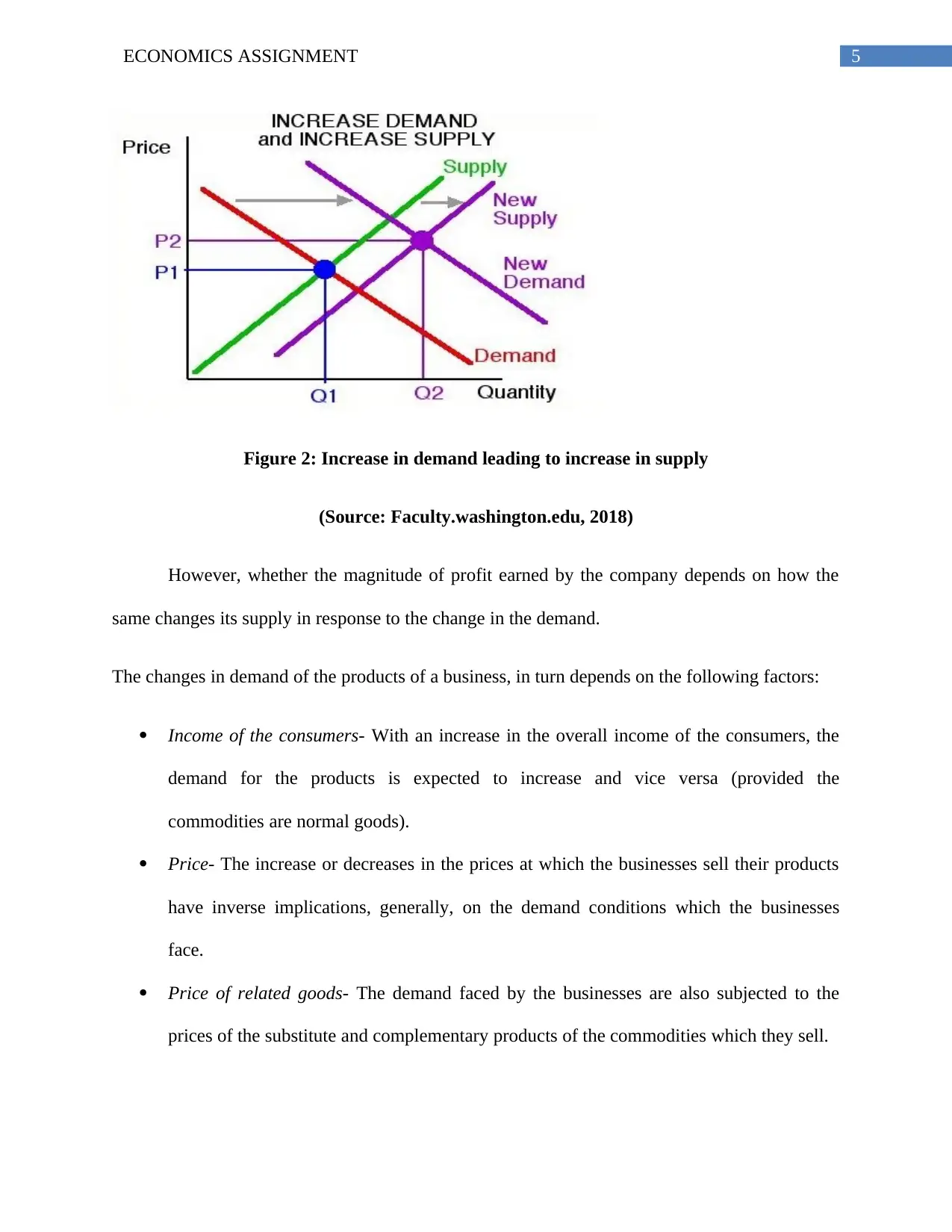
5ECONOMICS ASSIGNMENT
Figure 2: Increase in demand leading to increase in supply
(Source: Faculty.washington.edu, 2018)
However, whether the magnitude of profit earned by the company depends on how the
same changes its supply in response to the change in the demand.
The changes in demand of the products of a business, in turn depends on the following factors:
Income of the consumers- With an increase in the overall income of the consumers, the
demand for the products is expected to increase and vice versa (provided the
commodities are normal goods).
Price- The increase or decreases in the prices at which the businesses sell their products
have inverse implications, generally, on the demand conditions which the businesses
face.
Price of related goods- The demand faced by the businesses are also subjected to the
prices of the substitute and complementary products of the commodities which they sell.
Figure 2: Increase in demand leading to increase in supply
(Source: Faculty.washington.edu, 2018)
However, whether the magnitude of profit earned by the company depends on how the
same changes its supply in response to the change in the demand.
The changes in demand of the products of a business, in turn depends on the following factors:
Income of the consumers- With an increase in the overall income of the consumers, the
demand for the products is expected to increase and vice versa (provided the
commodities are normal goods).
Price- The increase or decreases in the prices at which the businesses sell their products
have inverse implications, generally, on the demand conditions which the businesses
face.
Price of related goods- The demand faced by the businesses are also subjected to the
prices of the substitute and complementary products of the commodities which they sell.
⊘ This is a preview!⊘
Do you want full access?
Subscribe today to unlock all pages.

Trusted by 1+ million students worldwide
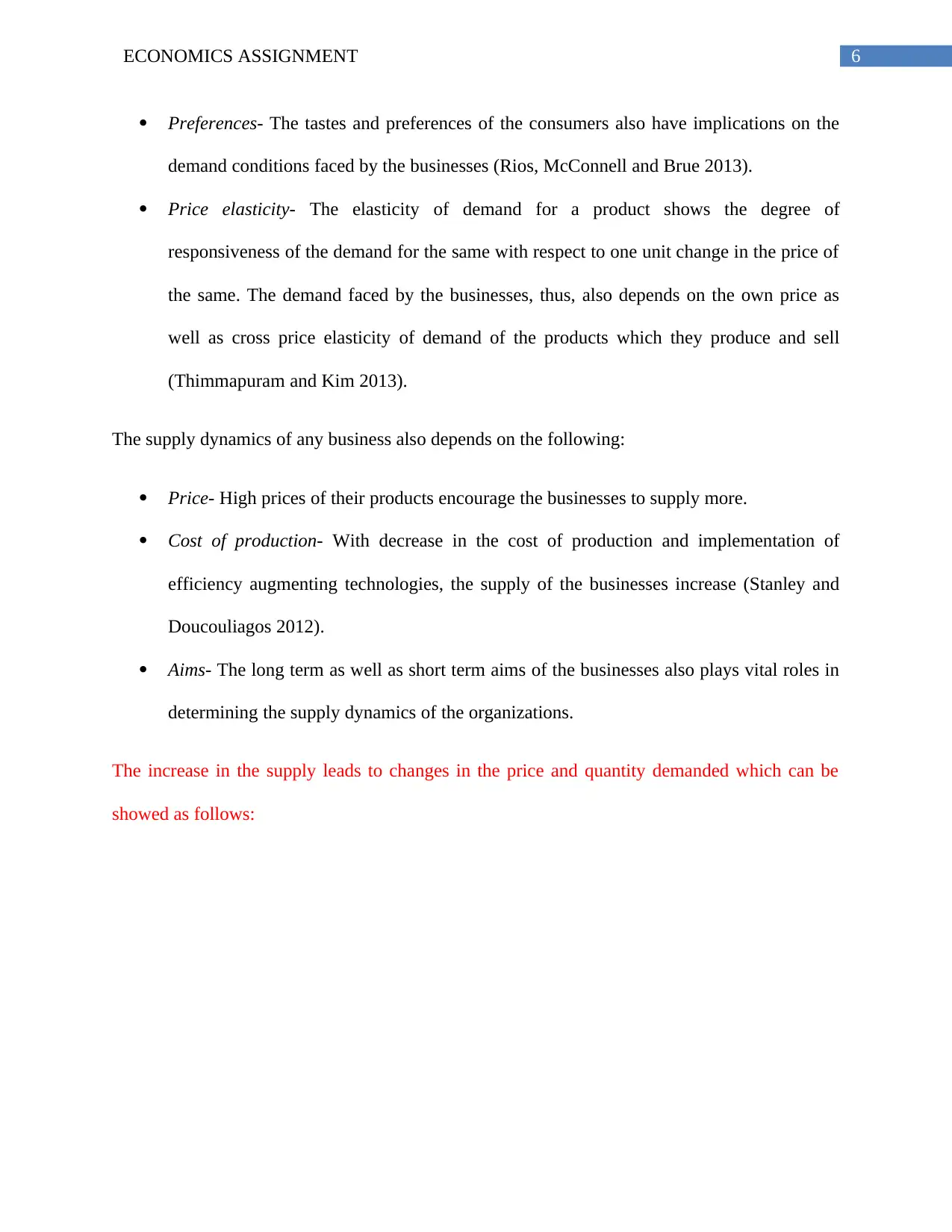
6ECONOMICS ASSIGNMENT
Preferences- The tastes and preferences of the consumers also have implications on the
demand conditions faced by the businesses (Rios, McConnell and Brue 2013).
Price elasticity- The elasticity of demand for a product shows the degree of
responsiveness of the demand for the same with respect to one unit change in the price of
the same. The demand faced by the businesses, thus, also depends on the own price as
well as cross price elasticity of demand of the products which they produce and sell
(Thimmapuram and Kim 2013).
The supply dynamics of any business also depends on the following:
Price- High prices of their products encourage the businesses to supply more.
Cost of production- With decrease in the cost of production and implementation of
efficiency augmenting technologies, the supply of the businesses increase (Stanley and
Doucouliagos 2012).
Aims- The long term as well as short term aims of the businesses also plays vital roles in
determining the supply dynamics of the organizations.
The increase in the supply leads to changes in the price and quantity demanded which can be
showed as follows:
Preferences- The tastes and preferences of the consumers also have implications on the
demand conditions faced by the businesses (Rios, McConnell and Brue 2013).
Price elasticity- The elasticity of demand for a product shows the degree of
responsiveness of the demand for the same with respect to one unit change in the price of
the same. The demand faced by the businesses, thus, also depends on the own price as
well as cross price elasticity of demand of the products which they produce and sell
(Thimmapuram and Kim 2013).
The supply dynamics of any business also depends on the following:
Price- High prices of their products encourage the businesses to supply more.
Cost of production- With decrease in the cost of production and implementation of
efficiency augmenting technologies, the supply of the businesses increase (Stanley and
Doucouliagos 2012).
Aims- The long term as well as short term aims of the businesses also plays vital roles in
determining the supply dynamics of the organizations.
The increase in the supply leads to changes in the price and quantity demanded which can be
showed as follows:
Paraphrase This Document
Need a fresh take? Get an instant paraphrase of this document with our AI Paraphraser

7ECONOMICS ASSIGNMENT
Figure 3: Increase in supply of commodities
(Source: As created by the author)
Together these dynamics in the demand and supply curves lead to the situation of
equilibrium at the point where the demand and the supply curve intersects each other, which can
be shown as follows:
Figure 3: Increase in supply of commodities
(Source: As created by the author)
Together these dynamics in the demand and supply curves lead to the situation of
equilibrium at the point where the demand and the supply curve intersects each other, which can
be shown as follows:

8ECONOMICS ASSIGNMENT
Figure 4: Equilibrium in the economy
(Source: As created by the author)
Any anomaly in the demand and supply can lead to excess demand or supply in the market,
which in turn can be detrimental for the producers and thus, has to be taken into consideration in
any kind of business organizations.
Business Behavior and Objectives: In Economic Context
From the above discussion, it can be seen that the microeconomic factors present in the
business environment have considerable implications on the activities of the businesses, thereby
indicating towards the fact that the economic factors play key roles in the business objectives and
behaviors, which include different decision makings in their operational framework.
Figure 4: Equilibrium in the economy
(Source: As created by the author)
Any anomaly in the demand and supply can lead to excess demand or supply in the market,
which in turn can be detrimental for the producers and thus, has to be taken into consideration in
any kind of business organizations.
Business Behavior and Objectives: In Economic Context
From the above discussion, it can be seen that the microeconomic factors present in the
business environment have considerable implications on the activities of the businesses, thereby
indicating towards the fact that the economic factors play key roles in the business objectives and
behaviors, which include different decision makings in their operational framework.
⊘ This is a preview!⊘
Do you want full access?
Subscribe today to unlock all pages.

Trusted by 1+ million students worldwide

9ECONOMICS ASSIGNMENT
The primary objective of any commercial enterprise, especially those of private concerns,
in terms of economics is that of profit maximization and cost minimization. While the former
objective is achieved by increasing the revenues the latter is achieved by implementing efficient
production processes, involving time and cost saving technologies and optimal number of labor
and capital resources (Kagel and Roth 2016). In this context, the economic concepts of scarcity
of resources and proper allocations of resources in the production process, hold considerable
importance in the operational framework and the behavior of the commercial organizations.
The business behaviors of the companies are also subjected to the three key questions of
economics- what to produce, how to produce and for whom to produce. The first question helps
the businesses to decide their area of ventures in the global market, while the second one leads to
the implementation of production processes optimal for the same. By answering the third
question, the company tries to select and categorize their target clientele and geographical
regions. Together these three basic questions of economics contribute considerably in
determining the overall decision-making processes, objectives and operational behaviors of the
commercial organizations across the globe (Fuss and McFadden 2014).
The production activities of companies are also related to the nature of the commodity
which they provide to the customers. In this context, the concept of elasticity of demand is found
to be highly relevant. The elasticity of demand refers to the degree of responsiveness of the
demand for a commodity in case of a unit change in the price of the same. If with the change in
price, the demand changes less than proportionately then the demand for the commodity is said
to be inelastic. On the other hand, if the demand changes more than proportionately then it is said
to be elastic in demand.
The primary objective of any commercial enterprise, especially those of private concerns,
in terms of economics is that of profit maximization and cost minimization. While the former
objective is achieved by increasing the revenues the latter is achieved by implementing efficient
production processes, involving time and cost saving technologies and optimal number of labor
and capital resources (Kagel and Roth 2016). In this context, the economic concepts of scarcity
of resources and proper allocations of resources in the production process, hold considerable
importance in the operational framework and the behavior of the commercial organizations.
The business behaviors of the companies are also subjected to the three key questions of
economics- what to produce, how to produce and for whom to produce. The first question helps
the businesses to decide their area of ventures in the global market, while the second one leads to
the implementation of production processes optimal for the same. By answering the third
question, the company tries to select and categorize their target clientele and geographical
regions. Together these three basic questions of economics contribute considerably in
determining the overall decision-making processes, objectives and operational behaviors of the
commercial organizations across the globe (Fuss and McFadden 2014).
The production activities of companies are also related to the nature of the commodity
which they provide to the customers. In this context, the concept of elasticity of demand is found
to be highly relevant. The elasticity of demand refers to the degree of responsiveness of the
demand for a commodity in case of a unit change in the price of the same. If with the change in
price, the demand changes less than proportionately then the demand for the commodity is said
to be inelastic. On the other hand, if the demand changes more than proportionately then it is said
to be elastic in demand.
Paraphrase This Document
Need a fresh take? Get an instant paraphrase of this document with our AI Paraphraser
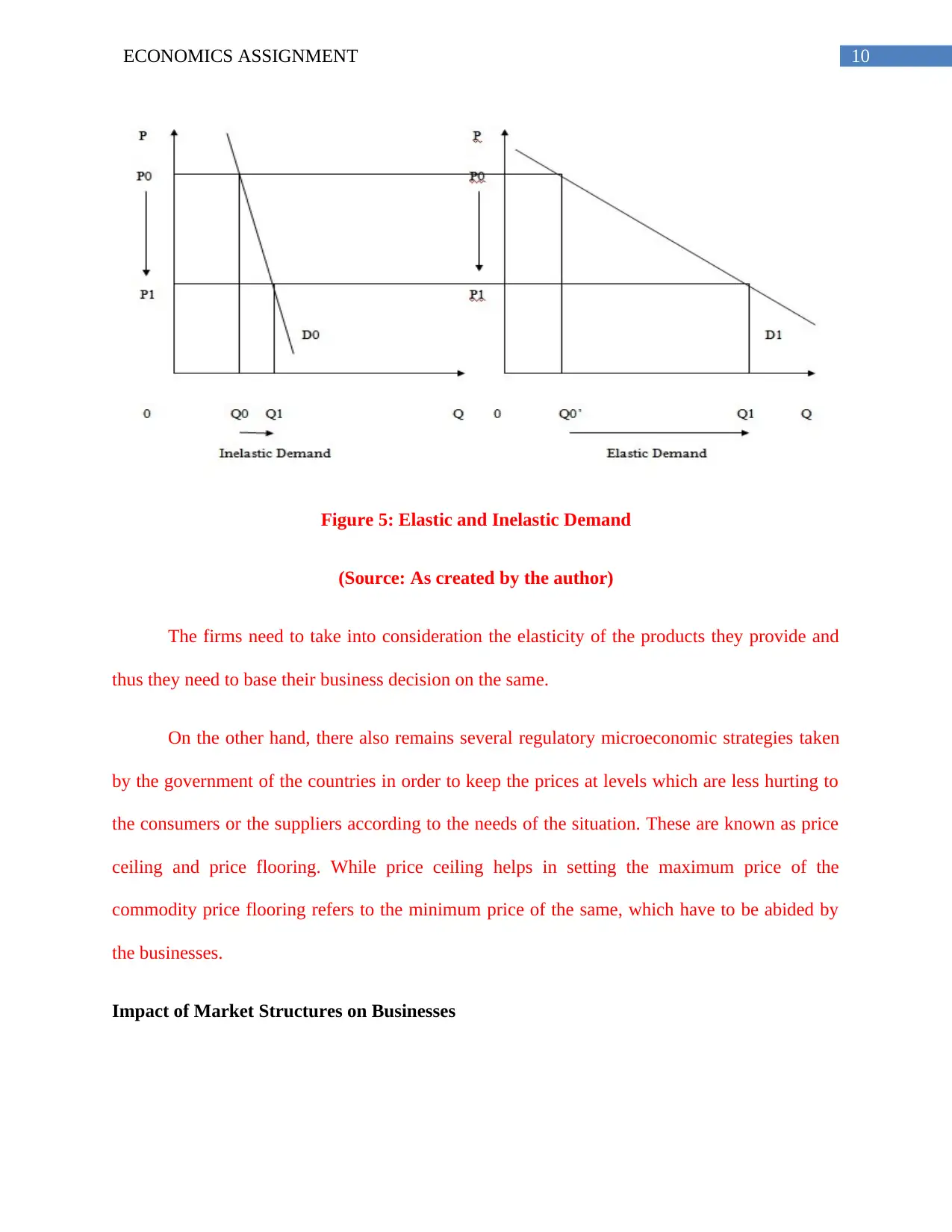
10ECONOMICS ASSIGNMENT
Figure 5: Elastic and Inelastic Demand
(Source: As created by the author)
The firms need to take into consideration the elasticity of the products they provide and
thus they need to base their business decision on the same.
On the other hand, there also remains several regulatory microeconomic strategies taken
by the government of the countries in order to keep the prices at levels which are less hurting to
the consumers or the suppliers according to the needs of the situation. These are known as price
ceiling and price flooring. While price ceiling helps in setting the maximum price of the
commodity price flooring refers to the minimum price of the same, which have to be abided by
the businesses.
Impact of Market Structures on Businesses
Figure 5: Elastic and Inelastic Demand
(Source: As created by the author)
The firms need to take into consideration the elasticity of the products they provide and
thus they need to base their business decision on the same.
On the other hand, there also remains several regulatory microeconomic strategies taken
by the government of the countries in order to keep the prices at levels which are less hurting to
the consumers or the suppliers according to the needs of the situation. These are known as price
ceiling and price flooring. While price ceiling helps in setting the maximum price of the
commodity price flooring refers to the minimum price of the same, which have to be abided by
the businesses.
Impact of Market Structures on Businesses
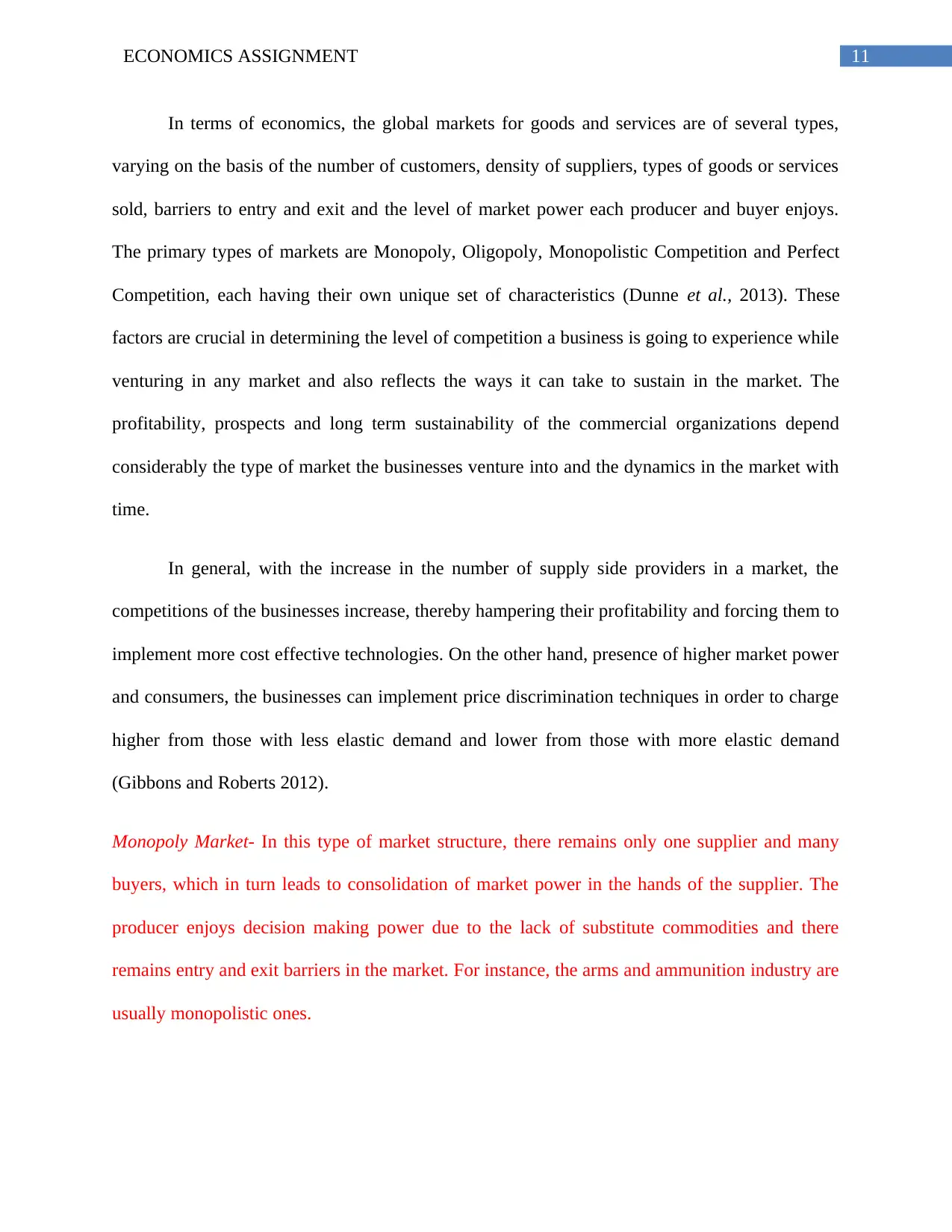
11ECONOMICS ASSIGNMENT
In terms of economics, the global markets for goods and services are of several types,
varying on the basis of the number of customers, density of suppliers, types of goods or services
sold, barriers to entry and exit and the level of market power each producer and buyer enjoys.
The primary types of markets are Monopoly, Oligopoly, Monopolistic Competition and Perfect
Competition, each having their own unique set of characteristics (Dunne et al., 2013). These
factors are crucial in determining the level of competition a business is going to experience while
venturing in any market and also reflects the ways it can take to sustain in the market. The
profitability, prospects and long term sustainability of the commercial organizations depend
considerably the type of market the businesses venture into and the dynamics in the market with
time.
In general, with the increase in the number of supply side providers in a market, the
competitions of the businesses increase, thereby hampering their profitability and forcing them to
implement more cost effective technologies. On the other hand, presence of higher market power
and consumers, the businesses can implement price discrimination techniques in order to charge
higher from those with less elastic demand and lower from those with more elastic demand
(Gibbons and Roberts 2012).
Monopoly Market- In this type of market structure, there remains only one supplier and many
buyers, which in turn leads to consolidation of market power in the hands of the supplier. The
producer enjoys decision making power due to the lack of substitute commodities and there
remains entry and exit barriers in the market. For instance, the arms and ammunition industry are
usually monopolistic ones.
In terms of economics, the global markets for goods and services are of several types,
varying on the basis of the number of customers, density of suppliers, types of goods or services
sold, barriers to entry and exit and the level of market power each producer and buyer enjoys.
The primary types of markets are Monopoly, Oligopoly, Monopolistic Competition and Perfect
Competition, each having their own unique set of characteristics (Dunne et al., 2013). These
factors are crucial in determining the level of competition a business is going to experience while
venturing in any market and also reflects the ways it can take to sustain in the market. The
profitability, prospects and long term sustainability of the commercial organizations depend
considerably the type of market the businesses venture into and the dynamics in the market with
time.
In general, with the increase in the number of supply side providers in a market, the
competitions of the businesses increase, thereby hampering their profitability and forcing them to
implement more cost effective technologies. On the other hand, presence of higher market power
and consumers, the businesses can implement price discrimination techniques in order to charge
higher from those with less elastic demand and lower from those with more elastic demand
(Gibbons and Roberts 2012).
Monopoly Market- In this type of market structure, there remains only one supplier and many
buyers, which in turn leads to consolidation of market power in the hands of the supplier. The
producer enjoys decision making power due to the lack of substitute commodities and there
remains entry and exit barriers in the market. For instance, the arms and ammunition industry are
usually monopolistic ones.
⊘ This is a preview!⊘
Do you want full access?
Subscribe today to unlock all pages.

Trusted by 1+ million students worldwide
1 out of 25
Related Documents
Your All-in-One AI-Powered Toolkit for Academic Success.
+13062052269
info@desklib.com
Available 24*7 on WhatsApp / Email
![[object Object]](/_next/static/media/star-bottom.7253800d.svg)
Unlock your academic potential
Copyright © 2020–2025 A2Z Services. All Rights Reserved. Developed and managed by ZUCOL.





